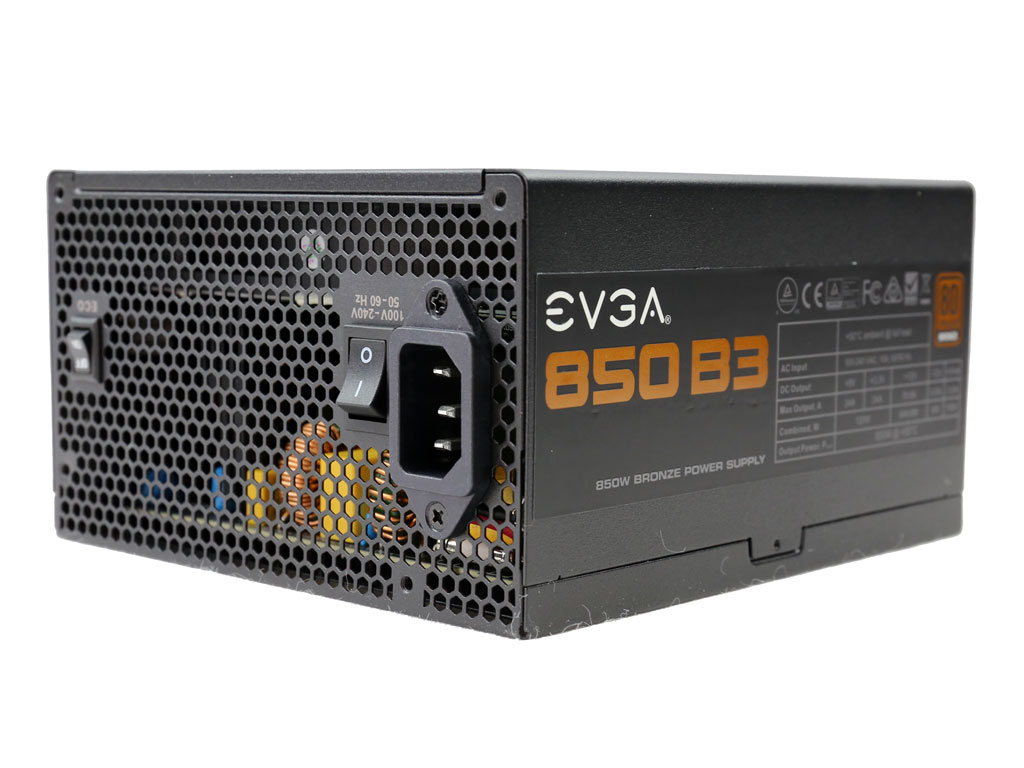EVGA 850 B3 PSU Review
Why you can trust Tom's Hardware
Load Regulation, Hold-Up Time & Inrush Current
To learn more about our PSU tests and methodology, please check out How We Test Power Supply Units.
Primary Rails And 5VSB Load Regulation
Load Regulation testing is detailed here.


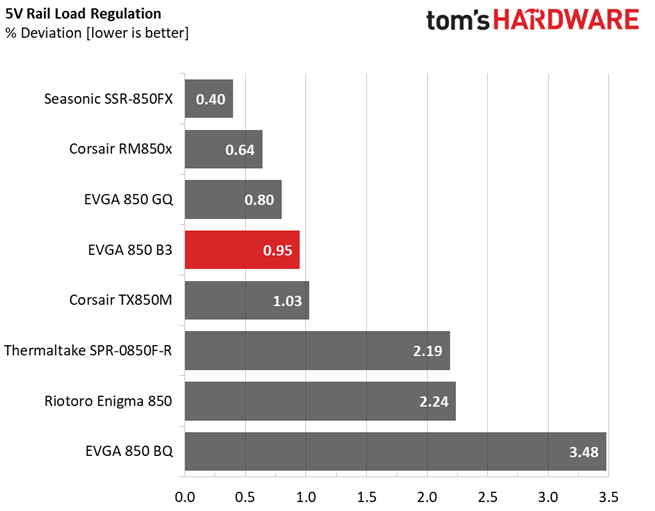
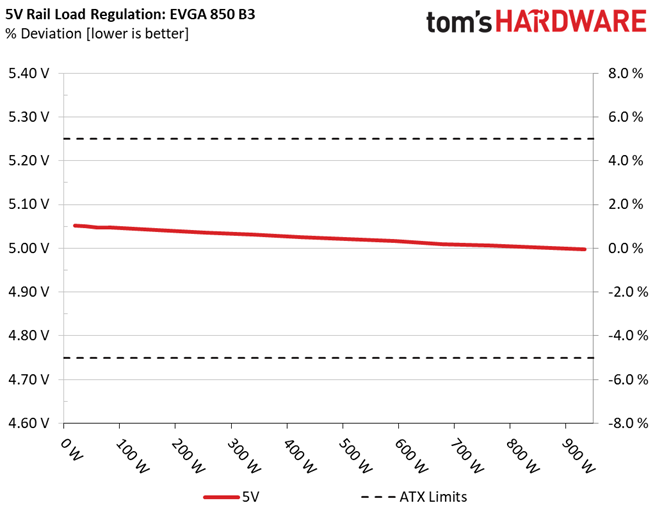
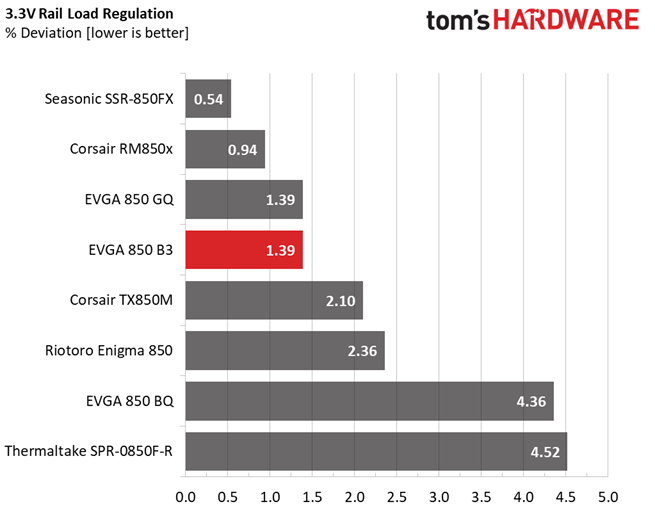
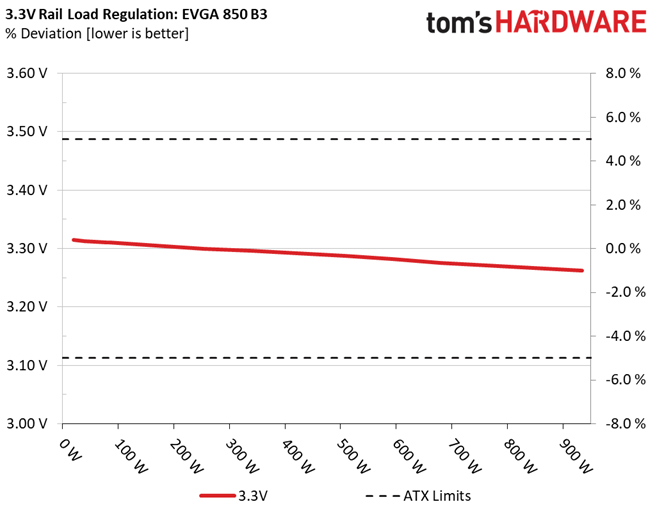


Hold-Up Time
Our hold-up time tests are described in detail here.







The hold-up time we observed is longer than 20ms, and the 850 B3's power-good signal is accurate.
Inrush Current
For details on our inrush current testing, please click here.
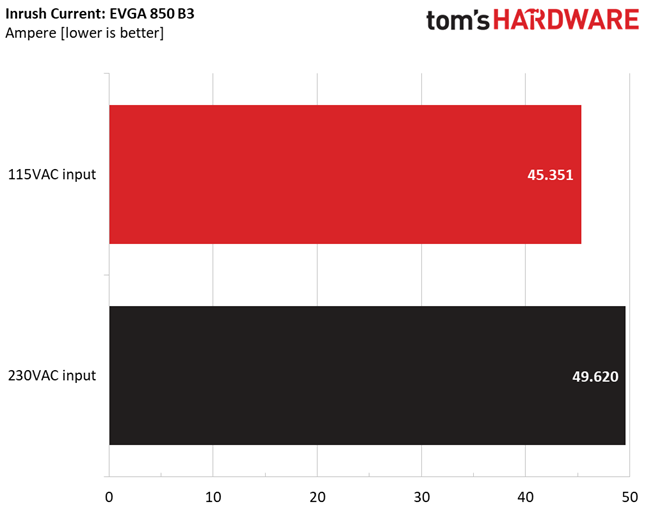

The inrush current is normal for this unit's capacity.
Load Regulation And Efficiency Measurements
The first set of tests reveals the stability of the voltage rails and the 850 B3's efficiency. The applied load equals (approximately) 10 to 110 percent of the PSU's maximum load in increments of 10 percentage points.
Get Tom's Hardware's best news and in-depth reviews, straight to your inbox.
We conducted two additional tests. During the first, we stressed the two minor rails (5V and 3.3V) with a high load, while the load at +12V was only 0.1A. This test reveals whether a PSU is compatible with Intel's C6/C7 sleep states or not. In the second test, we determined the maximum load the +12V rail could handle with minimal load on the minor rails.
| Test # | 12V | 5V | 3.3V | 5VSB | DC/AC (Watts) | Efficiency | Fan Speed (RPM) | Fan Noise (dB[A]) | Temps (In/Out) | PF/AC Volts |
|---|---|---|---|---|---|---|---|---|---|---|
| 1 | 5.210A | 1.985A | 1.991A | 0.980A | 84.785 | 80.878% | 0 | <6.0 | 43.15°C | 0.954 |
| 12.128V | 5.047V | 3.310V | 5.092V | 104.831 | 38.55°C | 115.18V | ||||
| 2 | 11.444A | 2.971A | 2.992A | 1.181A | 169.620 | 85.014% | 0 | <6.0 | 45.29°C | 0.982 |
| 12.125V | 5.041V | 3.305V | 5.076V | 199.521 | 40.50°C | 115.18V | ||||
| 3 | 18.052A | 3.478A | 3.510A | 1.380A | 254.853 | 86.712% | 1218 | 27.3 | 41.24°C | 0.989 |
| 12.119V | 5.036V | 3.300V | 5.060V | 293.906 | 46.13°C | 115.19V | ||||
| 4 | 24.648A | 3.977A | 4.001A | 1.584A | 339.727 | 87.533% | 1276 | 29.0 | 41.29°C | 0.992 |
| 12.112V | 5.032V | 3.296V | 5.045V | 388.113 | 46.48°C | 115.20V | ||||
| 5 | 30.912A | 4.974A | 5.009A | 1.785A | 424.624 | 87.466% | 1338 | 30.7 | 41.63°C | 0.994 |
| 12.104V | 5.026V | 3.292V | 5.029V | 485.473 | 46.95°C | 115.22V | ||||
| 6 | 37.193A | 5.977A | 6.022A | 1.994A | 509.607 | 86.950% | 1462 | 34.3 | 42.72°C | 0.995 |
| 12.094V | 5.021V | 3.287V | 5.010V | 586.089 | 48.26°C | 115.19V | ||||
| 7 | 43.502A | 6.981A | 7.038A | 2.199A | 594.560 | 86.345% | 1600 | 36.1 | 43.47°C | 0.996 |
| 12.079V | 5.017V | 3.282V | 4.992V | 688.583 | 49.30°C | 115.20V | ||||
| 8 | 49.797A | 7.987A | 8.058A | 2.410A | 679.494 | 85.549% | 1743 | 40.0 | 44.14°C | 0.996 |
| 12.071V | 5.010V | 3.275V | 4.975V | 794.273 | 50.18°C | 115.18V | ||||
| 9 | 56.545A | 8.488A | 8.583A | 2.414A | 764.493 | 84.596% | 1885 | 42.2 | 44.62°C | 0.996 |
| 12.060V | 5.007V | 3.271V | 4.965V | 903.702 | 50.88°C | 115.18V | ||||
| 10 | 63.031A | 9.005A | 9.088A | 3.036A | 849.365 | 83.782% | 1885 | 42.2 | 45.71°C | 0.997 |
| 12.052V | 5.002V | 3.267V | 4.935V | 1013.785 | 52.33°C | 115.18V | ||||
| 11 | 70.143A | 9.016A | 9.099A | 3.042A | 934.308 | 82.482% | 2014 | 43.1 | 46.20°C | 0.997 |
| 12.041V | 4.997V | 3.262V | 4.925V | 1132.742 | 53.15°C | 115.18V | ||||
| CL1 | 0.098A | 14.023A | 14.004A | 0.004A | 117.803 | 77.549% | 1432 | 32.6 | 44.59°C | 0.974 |
| 12.123V | 5.027V | 3.292V | 5.107V | 151.908 | 50.67°C | 115.20V | ||||
| CL2 | 70.778A | 1.004A | 1.003A | 1.002A | 865.942 | 83.783% | 2003 | 43.0 | 47.16°C | 0.996 |
| 12.046V | 5.011V | 3.278V | 5.022V | 1033.550 | 53.82°C | 115.18V |
Load regulation is pretty tight on every rail, particularly considering this PSU's price point. Better still, the 850 B3 delivers more than its full power at 46°C.
The registered efficiency levels are low though, especially under full load. And the fan speed profile is quite aggressive once the operating temperature and load increase. Of course, this is a low-efficiency PSU, so high fan speeds are expected; they help keep the internal temperature manageable. As a result, EVGA's 850 B3 easily satisfies the 80 PLUS Bronze requirements, even under high operating temperatures.
MORE: Best Power Supplies
MORE: How We Test Power Supplies
MORE: All Power Supply Content
Current page: Load Regulation, Hold-Up Time & Inrush Current
Prev Page Teardown & Component Analysis Next Page Efficiency, Temperature & Noise
Aris Mpitziopoulos is a contributing editor at Tom's Hardware, covering PSUs.
-
orionfotl There's a typo in the Final Analysis: "Although we're glad the 850 B3 didn't blow up like the 450W model, this is our second (so fat) B3-series power supply to die on the bench."Reply
So fat.
Shame on the PSU. -
Realist9 Part of what I got from this review and the associated charts is that my next psu will likely be a Corsair unit.Reply -
dstarr3 It seems like the general wisdom is still "Don't buy a PSU unless it has a 7- to 10-year warranty." The best products from the best OEMs always come with those warranties lately.Reply -
Aris_Mp If you ask me the warranty isn't an indication from the moments it is 5 years long. On the other hand when a company avoids sending some specific PSUs for review, then the whole thing looks suspicious.Reply -
dstarr3 Reply20217010 said:If you ask me the warranty isn't an indication from the moments it is 5 years long. On the other hand when a company avoids sending some specific PSUs for review, then the whole thing looks suspicious.
I don't necessary mean that longer warranty = better product. I just mean that there are some OEMs that are better than the rest, and their best PSUs are the best on the market, and all those best PSUs happen to have 7- to 10-year warranties on them. So if you see that warranty on a PSU right now, you can reasonably assume that it is one of the best models from one of the best OEMs. -
Olle P I don't totally agree with the "Pros" and "Cons":Reply
* Six 8-pin PCIe-connectors are supposed to be capable of delivering up to 900W. This PSU can't handle that.
* The efficiency is as advertised. That's neither a "Con" nor a "Pro". (In fact I'm impressed with the efficiency at 20W load. Expected worse.)
* Sleeve bearing is what makes the fan relatively quiet, so it's not a "Con" per se. Had it been a ball bearing fan you'd written "High noise level" as a "Con" instead. -
Aris_Mp Efficiency is a con in general. It is lowReply
If the fan had DBB and an optimal fan profile then it wouldn't be a con. A sleeve bearing fan in a 100 buck PSU doesn't look good and those type of bearings are suited for horizontal installation so they should normally be avoided in PSUs. -
al3xand3r Hi Aris, congratulations for the wonderful review and all of your work.Reply
I've seen all of your reviews, but one thing I do not understand compared to other review sites and that's related to the advanced transient tests. For example, the be quiet! Pure Power 10 600W PSU, in Advanced Transient Test at +12V, 20% - 20ms has a voltage drop of 0.211V. At 50% load 20 ms is a voltage drop of 0.222 volts. Instead, at ardOCP, the same PSU records a 0.520 volt voltage drop at 20% load - 10 ms and 0.540 volts at 50% load – 10ms. And that's a huge difference. And I do not think this difference is because of the reduced time from 20ms to 10ms because at 1ms wich is tougher the drops it's not as high. What is wrong with ardOCP methodology?
Is it possible that a quality PSU like this to have a voltage drop in load so high (0.52 Volts)? And that's just an example. At all the PSU’s I've seen on both sites are differences like this. Same as when you were doing only 50ms or 200ms. Is there any explanation for these figures that do not coincide?
Thank you

